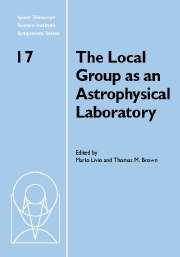 The Local Group as an Astrophysical Laboratory
The Local Group as an Astrophysical Laboratory Published online by Cambridge University Press: 12 May 2010
I review what is known about the general trends of metallicity and element abundance ratios in Local Group galaxies, and some implications of the abundance trends for chemical evolution. The Local Group spirals show radial metallicity gradients and a mean metallicity that increases with luminosity. The composition gradients steepen with decreasing galaxy luminosity, but are roughly similar when the gradients are derived per unit disk scale length. This suggests that the evolution of the metallicity gradient is closely tied to the evolution of the baryon distribution. The M31 and MilkyWay bulges appear to have similar metallicity distributions. The high [α/Fe] in Galactic bulge stars indicates that the bulge formed rapidly. Metallicity distributions for M31 and Galactic halo stars are also similar, except that M31 has more globular clusters that are metal-rich, possibly related to its larger bulge. M33 is anomalous in that its halo clusters may be significantly younger than the Galactic halo. Local Group irregular galaxies are metal-poor, and their mean metallicity correlates with galaxy luminosity. They have low effective yields, as derived from a comparison of mean metallicity with gas fraction, and the effective yield is correlated with galaxy rotation speed (or mass). This is evidence that the irregulars have lost metals to the IGM, either through galactic winds or stripping. Dwarf ellipticals in the Local Group are also metal-poor, and follow a similar metallicity-luminosity relation. The fact that the dEs have no gas also points to loss of metals as a significant factor in their evolution.
To save this book to your Kindle, first ensure [email protected] is added to your Approved Personal Document E-mail List under your Personal Document Settings on the Manage Your Content and Devices page of your Amazon account. Then enter the ‘name’ part of your Kindle email address below. Find out more about saving to your Kindle.
Note you can select to save to either the @free.kindle.com or @kindle.com variations. ‘@free.kindle.com’ emails are free but can only be saved to your device when it is connected to wi-fi. ‘@kindle.com’ emails can be delivered even when you are not connected to wi-fi, but note that service fees apply.
Find out more about the Kindle Personal Document Service.
To save content items to your account, please confirm that you agree to abide by our usage policies. If this is the first time you use this feature, you will be asked to authorise Cambridge Core to connect with your account. Find out more about saving content to Dropbox.
To save content items to your account, please confirm that you agree to abide by our usage policies. If this is the first time you use this feature, you will be asked to authorise Cambridge Core to connect with your account. Find out more about saving content to Google Drive.